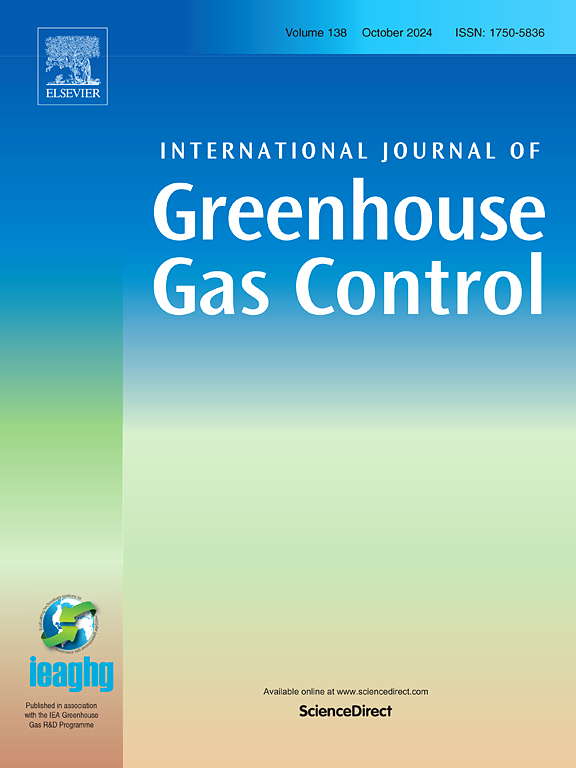改性镁煤基固碳充填材料的流动特性研究
IF 5.2
3区 工程技术
Q2 ENERGY & FUELS
International Journal of Greenhouse Gas Control
Pub Date : 2025-07-31
DOI:10.1016/j.ijggc.2025.104443
引用次数: 0
摘要
为了解决煤炭工业活动中温室气体排放和大量固体废物的问题,已经探索了碳封存回填材料,这些材料的流动性是回填过程中的关键因素。本研究制备了CO2改性镁煤基固体废物回填材料(CO2 - MCSB)。通过坍落度、流变、出血性试验和微观分析,考察了不同质量浓度和胶凝材料配比下CO2 - MCSB的流动和流变特性。通过选择质量浓度组的FA50-74和胶凝材料配比组的FA40参数组合,对流变试验装置进行改造,探讨二次曝气对CO2吸收量和流动性的影响。结果表明:随着质量浓度的增加,坍落度(142.5 ~ 132.0 mm)、膨胀率(50.8 ~ 25.0 cm)和出料率(6.03% ~ 2.21%)降低,屈服应力、塑性粘度和触变性增加;反之,增加粉煤灰在胶凝材料中的掺量,可提高坍落度(134.0 ~ 138.0 mm)、膨胀度(29.9 ~ 36.0 cm)和出胶率(2.01% ~ 2.78%),降低屈服应力、塑性粘度和触变性。CO2 - MCSB浆体流变行为符合H-B模型,流动与流变参数之间存在较强的线性相关关系。此外,FA50-74和FA40对二次曝气的研究表明,二次曝气不仅改善了CO2 - MCSB料浆的流动性,而且使CO2吸收量分别提高了21.86%和21.75%。该研究为设计和优化固碳回填浆的材料配比,以达到工程应用中理想的流动性能提供了有价值的见解。本文章由计算机程序翻译,如有差异,请以英文原文为准。
Study on the flow properties of modified magnesium-coal-based solid waste carbon sequestration backfill materials
To address greenhouse gas emissions and massive solid waste in coal industry activities, carbon sequestration backfill materials have been explored, with the fluidity of these materials being a critical factor in the backfill process. In this study, CO2-modified magnesium-coal based solid waste backfill materials (CO2−MCSB) were prepared. The flow and rheological properties of CO2−MCSB under different mass concentrations and cementitious material ratios were examined through slump, rheological, bleeding tests, and microscopic analyses. The impact of secondary aeration on CO2 uptake and fluidity was explored by modifying the rheological testing apparatus by using selected parameter combinations: FA50–74 from the mass concentration group and FA40 from the cementitious material ratios group. The results showed that increasing mass concentration reduced slump (142.5 to 132.0 mm), expansion (50.8 to 25.0 cm), and bleeding rate (6.03 % to 2.21 %), while increasing yield stress, plastic viscosity, and thixotropy. Conversely, increasing the proportion of fly ash in cementitious material raised slump (134.0 to 138.0 mm), expansion (29.9 to 36.0 cm), and bleeding rate (2.01 % to 2.78 %), while reducing yield stress, plastic viscosity, and thixotropy. The rheological behavior of CO2−MCSB slurry conforms H-B model, with strong linear correlations between flow and rheological parameters. Furthermore, studies on FA50–74 and FA40 about secondary aeration demonstrated that secondary aeration not only improved the fluidity of CO2−MCSB slurry but also increased CO2 uptake by 21.86 % and 21.75 %, respectively. This study provides valuable insights for designing and optimizing the material ratios of carbon sequestration backfill slurries to achieve desirable flow properties in engineering applications.
求助全文
通过发布文献求助,成功后即可免费获取论文全文。
去求助
来源期刊
CiteScore
9.20
自引率
10.30%
发文量
199
审稿时长
4.8 months
期刊介绍:
The International Journal of Greenhouse Gas Control is a peer reviewed journal focusing on scientific and engineering developments in greenhouse gas control through capture and storage at large stationary emitters in the power sector and in other major resource, manufacturing and production industries. The Journal covers all greenhouse gas emissions within the power and industrial sectors, and comprises both technical and non-technical related literature in one volume. Original research, review and comments papers are included.

 求助内容:
求助内容: 应助结果提醒方式:
应助结果提醒方式:


